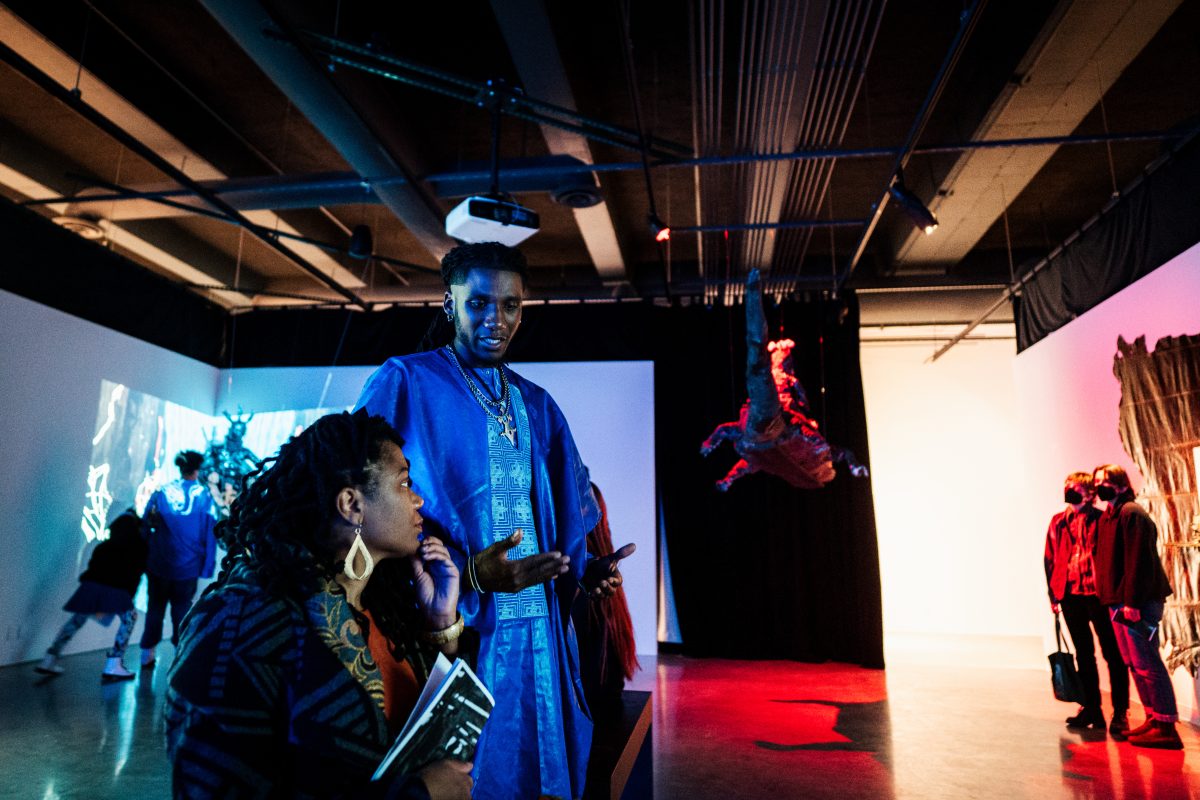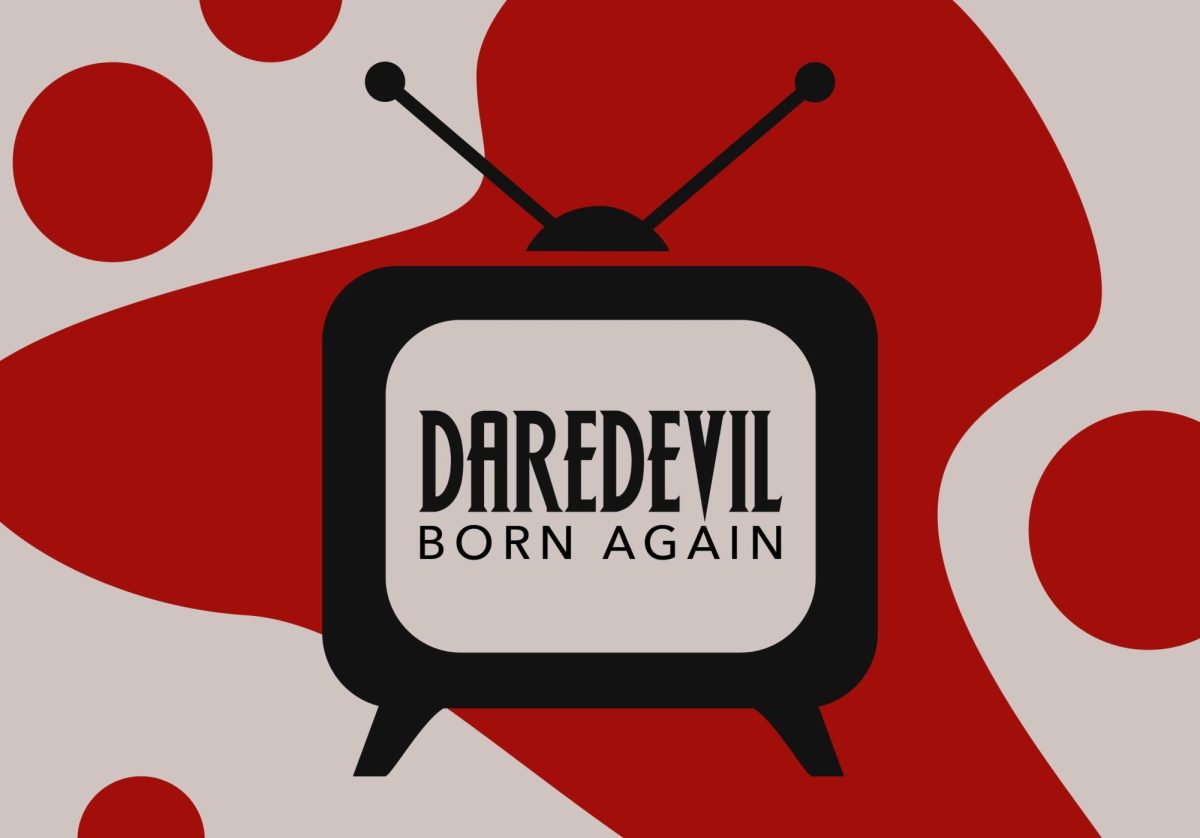The opening of Delta Passage, the collaborative thesis exhibition of the 2024 Master of Fine Arts cohort, easily drew over 100 people to the Katherine E. Nash Gallery in the Regis Center for Art East on Saturday.
The exhibition greeted people with the immensity of the artists’ love, care and passion, not only for their individual practices, but for each other as well.
The exhibition is an immersive confluence of the works of Namir Fearce, Whalen Polikoff and Calvin Stalvig. It features contemporary multimedia conceptual pieces that touch on “fugitive genealogies, nationalistic violence and otherworldly encounters,” according to an Instagram post by the University of Minnesota Department of Art.
Fearce, Polikoff and Stalvig first crossed paths in 2021 when they entered the master’s program together.
Delta Passage is the product of three years spent together in the program, which professor and director of graduate studies Diane Willow called “inevitably transformational.”
“I love Calvin and Whalen, and they really love me,” Fearce said in his artist talk preceding the reception. “I’ve come into a fortune by meeting them.”
Turning left upon entering the Nash Gallery leads to Stalvig’s installation “Ghost House,” a large tent made out of white translucent plastic tarp hanging above the ground in a room bathed in marbled light that’s constantly shifting in color.
The keywords Stalvig uses for “Ghost House” in his visitor’s guide include “haunting,” “protection,” “refuge” and “memory.”
Opposite “Ghost House” is another Stalvig installation, “Altar to Ursa Major.” Wood palettes and rough-hewn logs structure the shrine, which is filled with vases of tulips in varying stages of bloom that viewers were given to add to.
Among the tulips were lit and unlit candles and food and beverage offerings to a carved figurine of Ursa Major in the center and one real rainbow rose.
Stalvig said Delta Passage is “a haunting that we invite you to be haunted by.”
“Be not afraid, like the angels said,” Fearce said to the audience in his artist talk.
Polikoff’s work in Delta Passage, such as “Ewes Nestle Spine to Spine on a Bed of Sunning Perineum,” confronts the glorification and abstraction of state violence, particularly in America today but throughout history as well.
“This propaganda accumulates and is stored in the psyche,” Polikoff said in his visitor’s guide.
Polikoff’s work dissects that propaganda with acrylic on canvas paintings stretched and held in mid-air by free-standing orange frames. The paintings depict fluid figures with bulging eyes engaging in activities if not outwardly grotesque then suggestive of such.
In “Ewes,” a hairless being eats raw flesh off a table, his sinewy arm bleeding into the face of the being next to him. It evokes Francisco Goya’s 1823 painting “Saturn Devouring His Son.”
Similar to the myth Goya depicted in his painting, Polikoff’s painting references a system bent on destroying the people within it so it won’t be overthrown.
Polikoff said he’s graduating the master’s program with “a better understanding of what it means to live with conviction.”
Enclosed in the middle of the gallery is Fearce’s work, a collection called “Hi Cotton.” The familiar opening notes of “Christmastime is Here” correspond with a stop-motion animation of a figurine of a Black child moving throughout a cardboard city. Soon after the lyrics start, however, the voice purposefully falls out of sync with the song as they sing of “lots of blood and tears.”
“How can I believe that this is really how it is?” the voice asks.
Like Polikoff, Fearce asks in his visitor’s guide how to survive in “a world that is designed to kill you.”
He does so through utilizing the tradition of the trickster deity, who is depicted in both still and moving images in Delta Passage, in order to tap into collective imagination.
Sculpted primordial figures, all of which have puffs of cotton growing out of their heads, populate the space, hanging and swinging gently from the ceiling. Fearce’s combination of video and physical movement create a space that is truly alive.
The aliveness of the space is cemented with a shrine on one of the walls featuring all of the figurines in Fearce’s videos in front of photos of the trickster. The physicality of the characters helps to fully incorporate viewers into the space. Fundamentally, Fearce’s work –– and all of Delta Passage –– is something to be consumed by.
In practice, Delta Passage confronts the professionalization of artmaking with the love and tenderness its featured artists share with one another. That love is what allows the work to flow so well through the Nash Gallery, creating an immersive experience that is truly alive and makes it impossible to leave unaffected.
Delta Passage is open for viewing at the Nash Gallery until April 13.














